Manchester United and Roma played out one of the best European ties this season in terms of entertainment in the first leg of the UEFA Europa League tie between the two clubs. Ole Gunnar Solskjaer’s side came away with a deserved 6-2 victory despite being 2-1 down at the interval, truly a tale of two halves as the cliché goes.
The tie is all but over now and United certainly have one foot in the door of the final after an incredible second-half performance. The first half lacked a lot of quality from both sides although Roma were certainly the better and more organised team tactically.
However, as the Giallorossi have shown time and time again this season, there seems to be a massive mental block partnered with tactical naivety from Paulo Fonseca and his side as Roma came out in the second half, leaving an extraordinary amount of space for United’s quality forwards to play into as opposed to being more conservative and trying to protect a shocking lead.
After Edinson Cavani equalised to make it 2-2 merely minutes after the commencement of the second half, the Roma players’ heads dropped and eventually succumbed to a plethora of quality attacks from the home side.
In this tactical analysis article, we will discuss the tactics used by both sides. It will be an analysis of both sides’ weaknesses and strengths as well as tactical tweaks by the managers which ultimately led to the absurd scoreline.
Lineups and formations
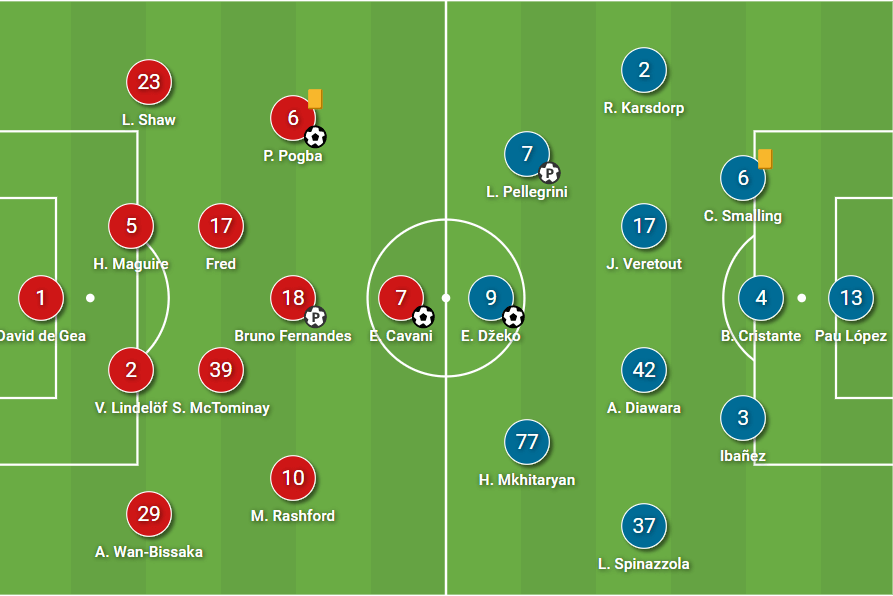
There was nothing surprising about the lineups or formations from both sides when the team news was announced an hour before kick-off. Both Solskjaer and Fonseca are quite rigid in their tactical approaches to games in terms of the formation and personnel that they choose and so this match was no different.
Manchester United lined up as expected in a 4-2-3-1 formation with David de Gea in net, protecting the goal behind a back four comprising of Luke Shaw, Harry Maguire, Victor Lindelof, and Aaron Wan-Bissaka. This has been the main back five this season although Dean Henderson has become the first-choice goalkeeper for United in their Premier League games recently.
The double-pivot in front of the defensive line was Scott McTominay and Fred, with Marcus Rashford flanking Roma on the right and Pogba on the left, although Pogba tends to drift more to the halfspace and plays in between the lines as a second number 10 next to Bruno Fernandes who remained in the starting eleven. Edinson Cavani led the line as the sole striker.
For Roma, Fonseca set his side up in their usual 3-4-2-1 with Pau Lopez in goal, who was quickly replaced with Antonio Mirante following a shoulder injury. The back three was made up of Chris Smalling on the right, Brian Cristante as the central centre-back, and Roger Ibanez on the left with both Leonardo Spinazzola and Rick Karsdorp as the wingbacks.
The double-pivot in midfield was Amadou Diawara alongside Jordan Veretout, although like Lopez, Veretout came off after five minutes with a hamstring problem and was replaced by Gonzalo Villar. To complete the team, the front three was made up of Roma’s typical attacking players with Henrikh Mkhitaryan and Lorenzo Pellegrini essentially playing as two number ‘10s’ and Edin Dzeko as the lone centre-forward.
Stifling United’s build-up play
For football purists who enjoy excellent and fluid build-up play with inspiring passing patterns to beat a high-press, this certainly was not the game for you. Both sides had success in stifling each other’s ability to play their way out of the build-up phase and into more progressive areas of the pitch, particularly the away side in the first half.
Manchester United set up in their usual 4-2-3-1 as we already discussed. When they were building out from the back, this turned into more of a 2-4-3-1 + the goalkeeper. Both Maguire and Lindelof would push to the edge of the box to cover the width and allow de Gea to be the central player in the first build-up line comprising of three players.
The two fullbacks would push up to the second line alongside the double-pivot who sat behind the opposition’s first line of pressure, whilst Pogba would then sit in the left halfspace behind Roma’s second line.
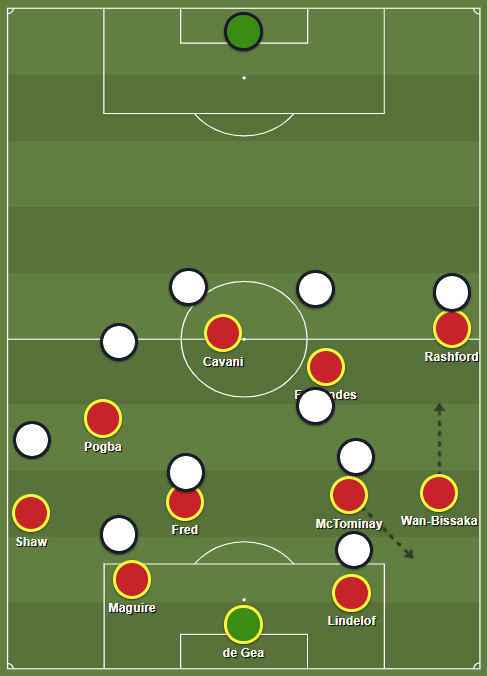
This is generally how United look whilst in possession, although it did fluctuate at times when McTominay dropped next to Lindelöf in the right halfspace as the team moved slightly further up the pitch, which in turn allowed the fullbacks to get higher.
When United were in this area of the pitch though, Roma had a specific man-oriented pressing system to stifle the home side’s ability to progress through the thirds of the pitch. It involved good communication from all the players involved and it worked quite well for large parts of the game, either forcing United long or else causing them to make errors in dangerous areas of the pitch.
Roma’s shape when they were pressing Man United high resembled a 5-1-2-2, although this would change depending on the situation to look more like with certain players having to perform different roles. At times, Karsdorp would push up and mark Luke Shaw whilst Chris Smalling was tasked with closing down Pogba in the halfspace so it can be difficult to put an exact formation on their structure.
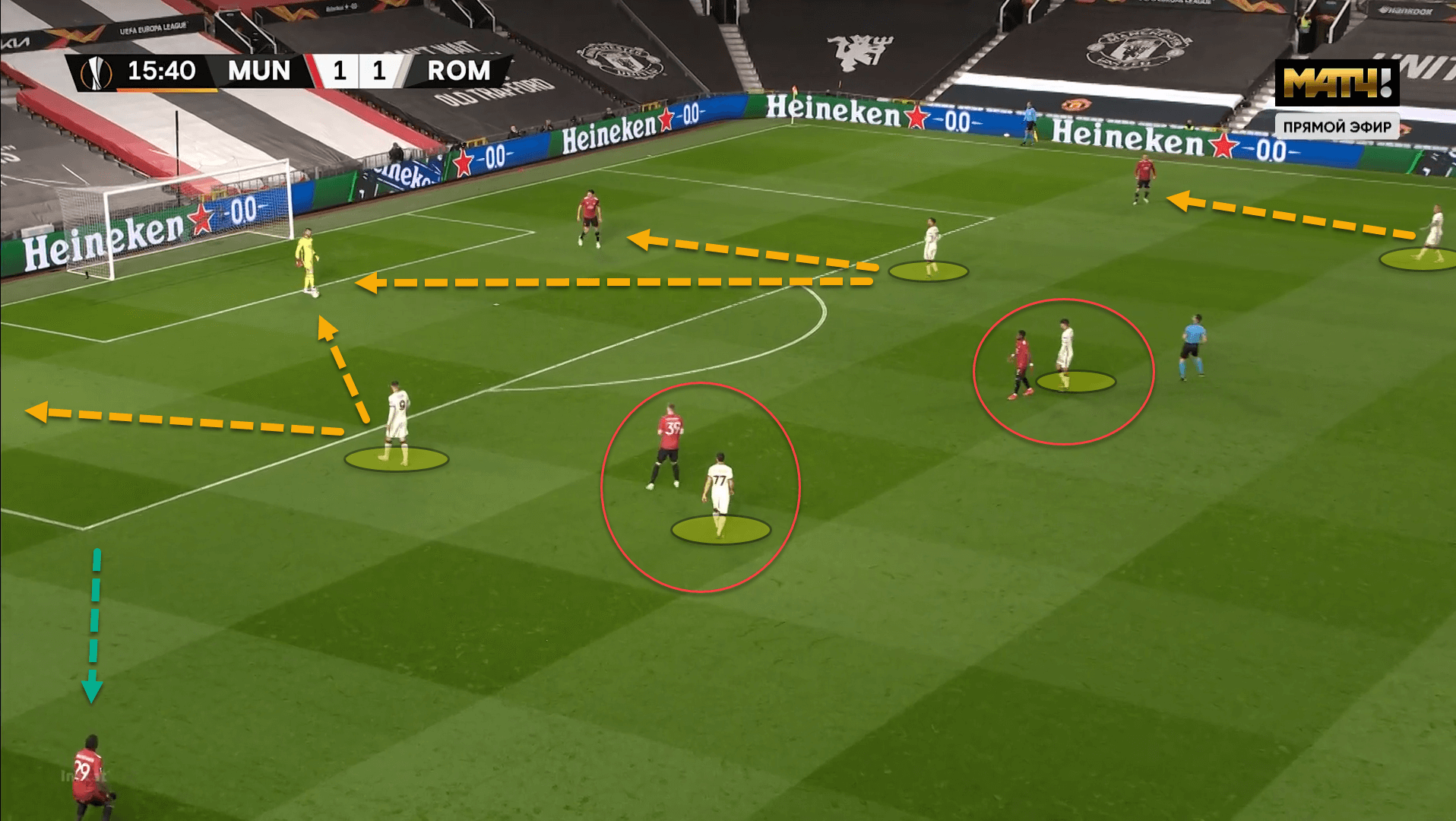
We can see Roma’s pressing system from the image above. When the ball was central, Dzeko and Pellegrini were tasked with pressing the centre-backs and the goalkeeper. Villar would push up and man-mark Fred tightly whilst Mkhitaryan was tasked with sitting on McTominay.
As already mentioned, Karsdorp high-pressed Shaw, and Smalling marked Pogba so the only free player was Aaron Wan-Bissaka. Roma’s left wingback could not move out to close down Wan-Bissaka as he was being pinned by Marcus Rashford staying wide on the right which meant that the right-back was constantly an open option to play to when United needed to play out.
This was not the option that United wanted as link-up play between Pogba and Shaw on the left side was a higher quality option for them, but due to the aggressive press of Smalling on Pogba, a lot of the time this was not a viable option.
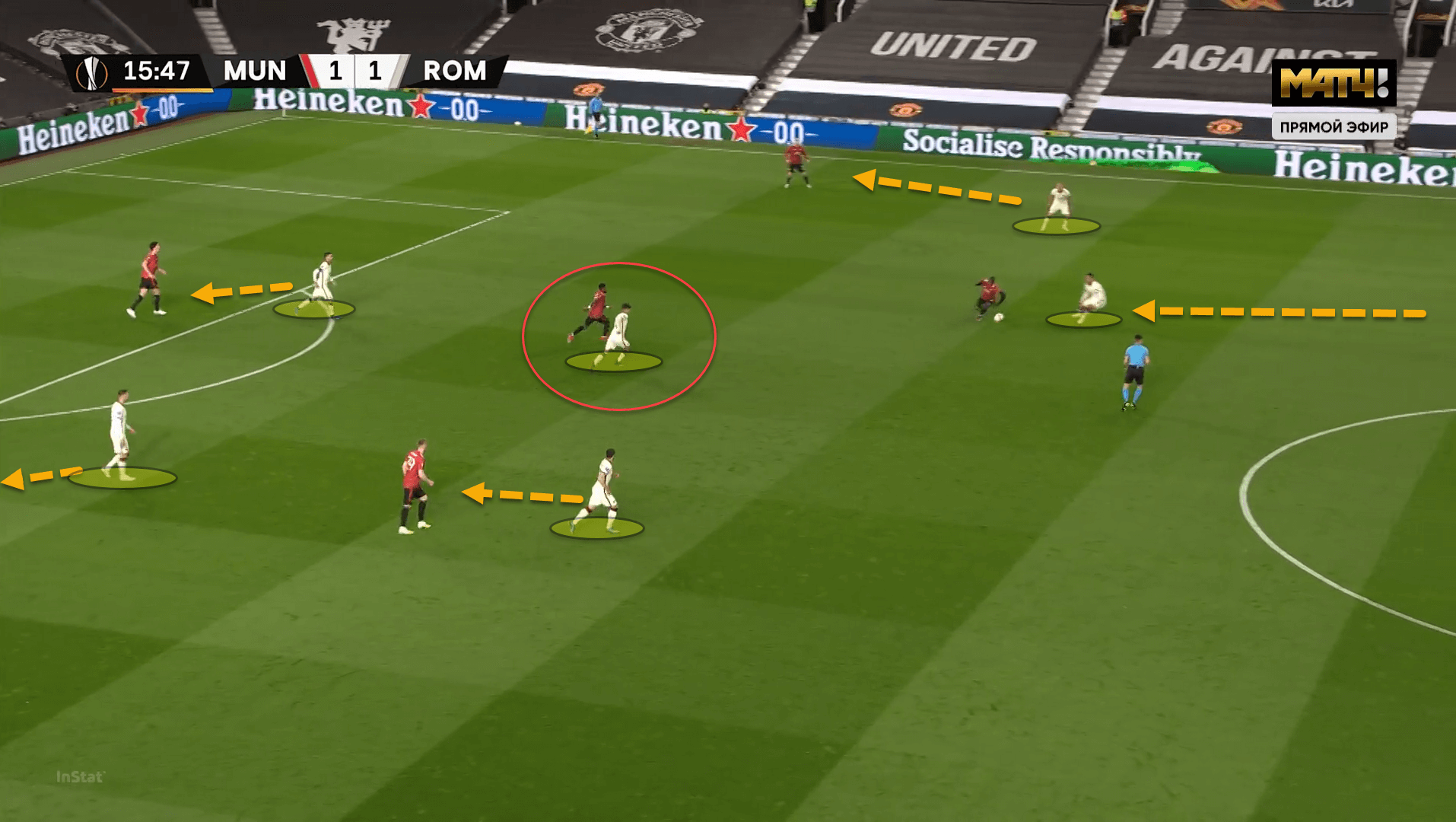
Here is an example of an attempt to play in Pogba in the halfspace to progress United further up the pitch but an attempt that failed and allowed Roma to transition to attack in a dangerous area. Smalling had left his post in the backline to track Pogba in a deep area and get tight to him to prevent him from receiving with a 180-degree half-turn and driving forward.
Instead, due to the English defender’s aggressive marking, Pogba tried to shift the ball to the right and take it around Smalling but slipped and Roma were in an optimal position to transition.
On the opposite side, when the ball was played out to the free Wan-Bissaka, Roma’s structure would change. Mkhitaryan would leave McTominay free to go and close down Wan-Bissaka while Dzeko would instead drop onto McTominay to ensure that the Scot was not free to receive.
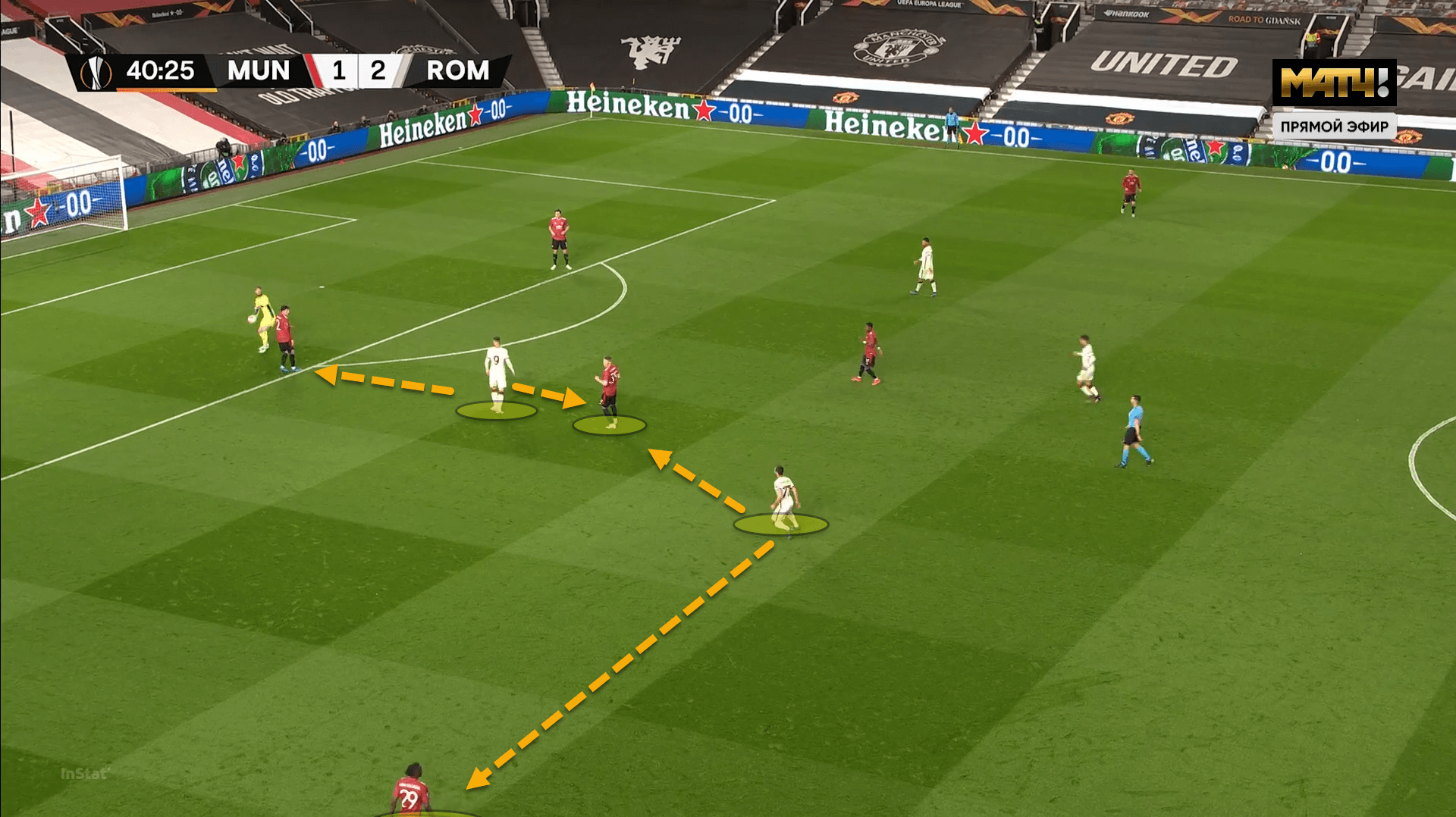
However, in theory, this was a good idea, but it put a lot of strain on Mkhitaryan who had to constantly switch back and forth between the two players, and if he was unable to reach Wan-Bissaka quickly enough, United had an option to progress out and further up the pitch.
Against Roma, United had more attacks down the right flank than any other area of the pitch, but they also had an xG of zero down this side so you can see why Solskjaer was desperately trying to get Pogba and Shaw on the ball.
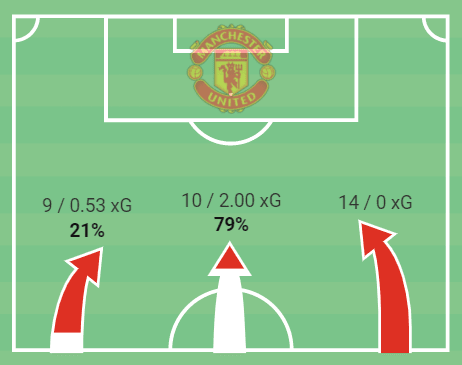
When Roma’s initial press was broken, they would drop back into a deep defensive block in a 5-4-1 so as to not give up any space for runners in behind.
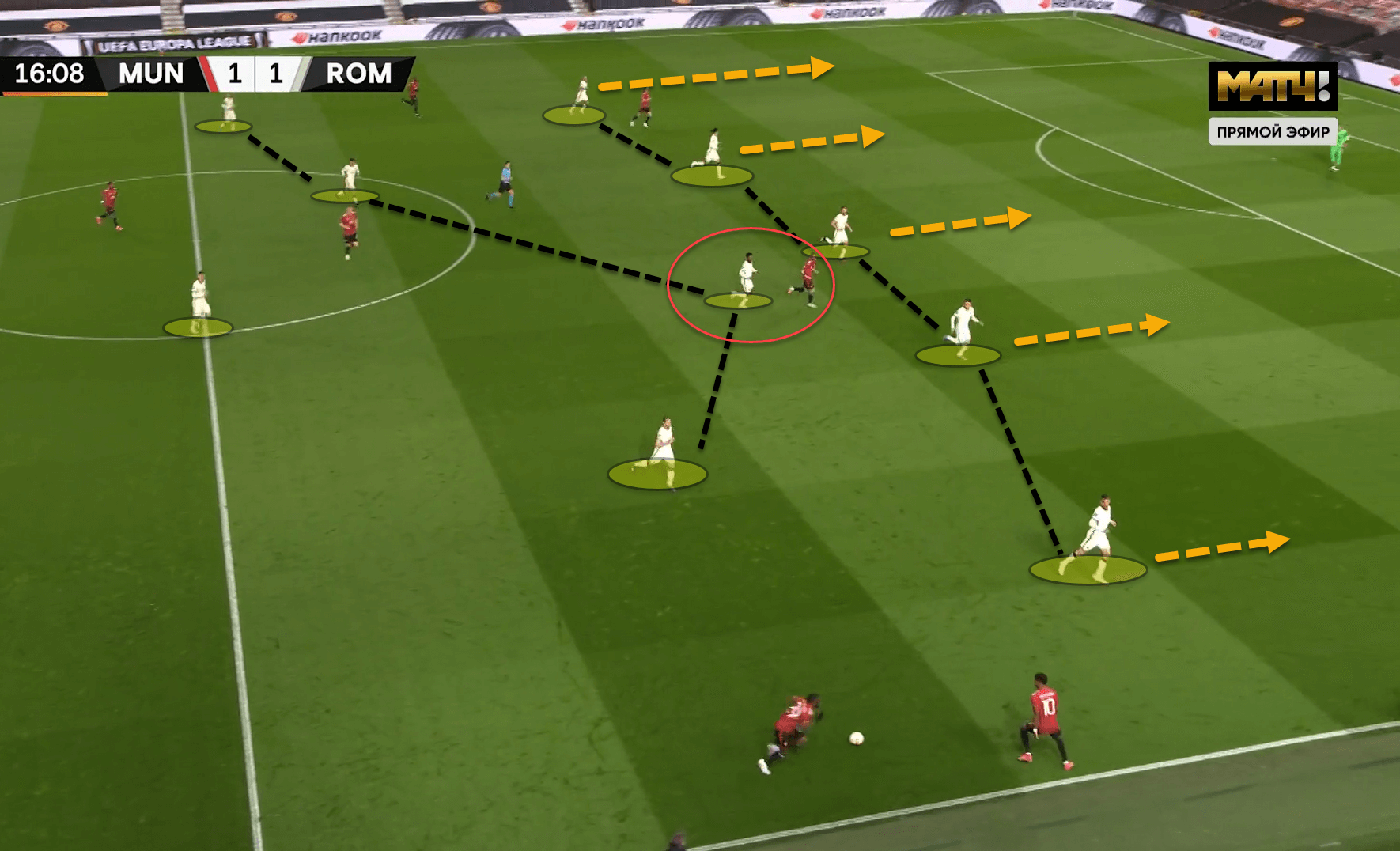
Breaking through Roma’s low block using third-man runs
In the first half, Roma were quite difficult to break down at times, especially when they managed to structure themselves into a low block. The main aim of their defensive set up was to stay compact between the lines and be aggressive to the players looking to receive in the halfspace.
United tried a number of different positional rotations and interchanges to potentially get players free over on the left flank and left halfspace but it was to avail. Often, Shaw and Pogba would switch positions with Shaw inverting centrally to try and disorientate Roma but the Giallorossi held firm.
United even tried to create wide overloads on the left with Rashford and Fernandes coming across but the nature of Roma’s compact 5-4-1 low block meant that they could always match the number to prevent the overload.
The Reds could have attempted to switch the play over to the far-side to Wan-Bissaka who was free in space but, without disrespecting the fullback, he lacks threat and ability in the final third so Roma were not overly worried about this.
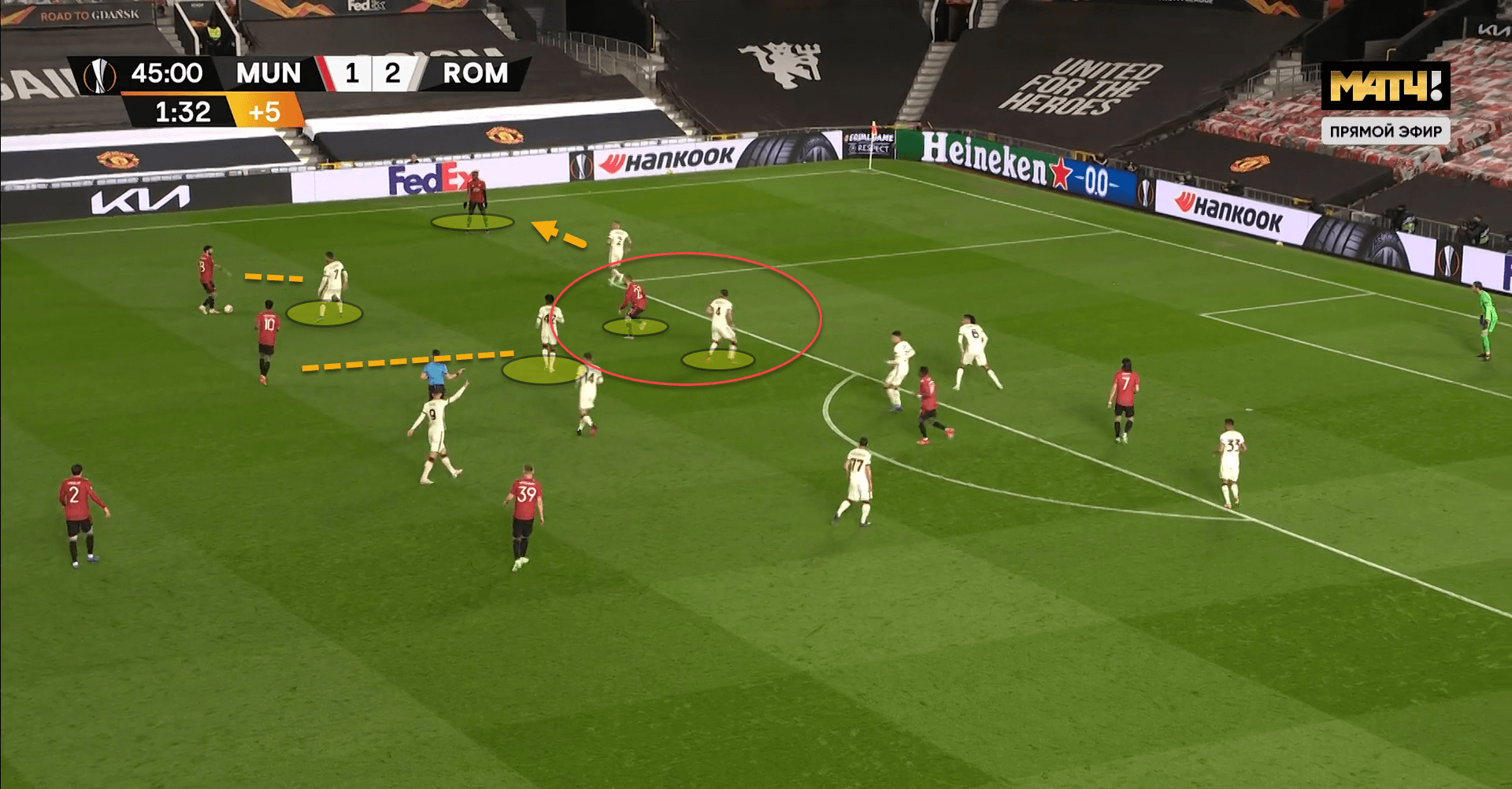
However, one way of breaking down Roma’s defensive block which worked perfectly for United was third-man runs in behind. In the first-half, we only really saw this once, which led to the opening goal of the game from some utterly fantastic team and individual play.
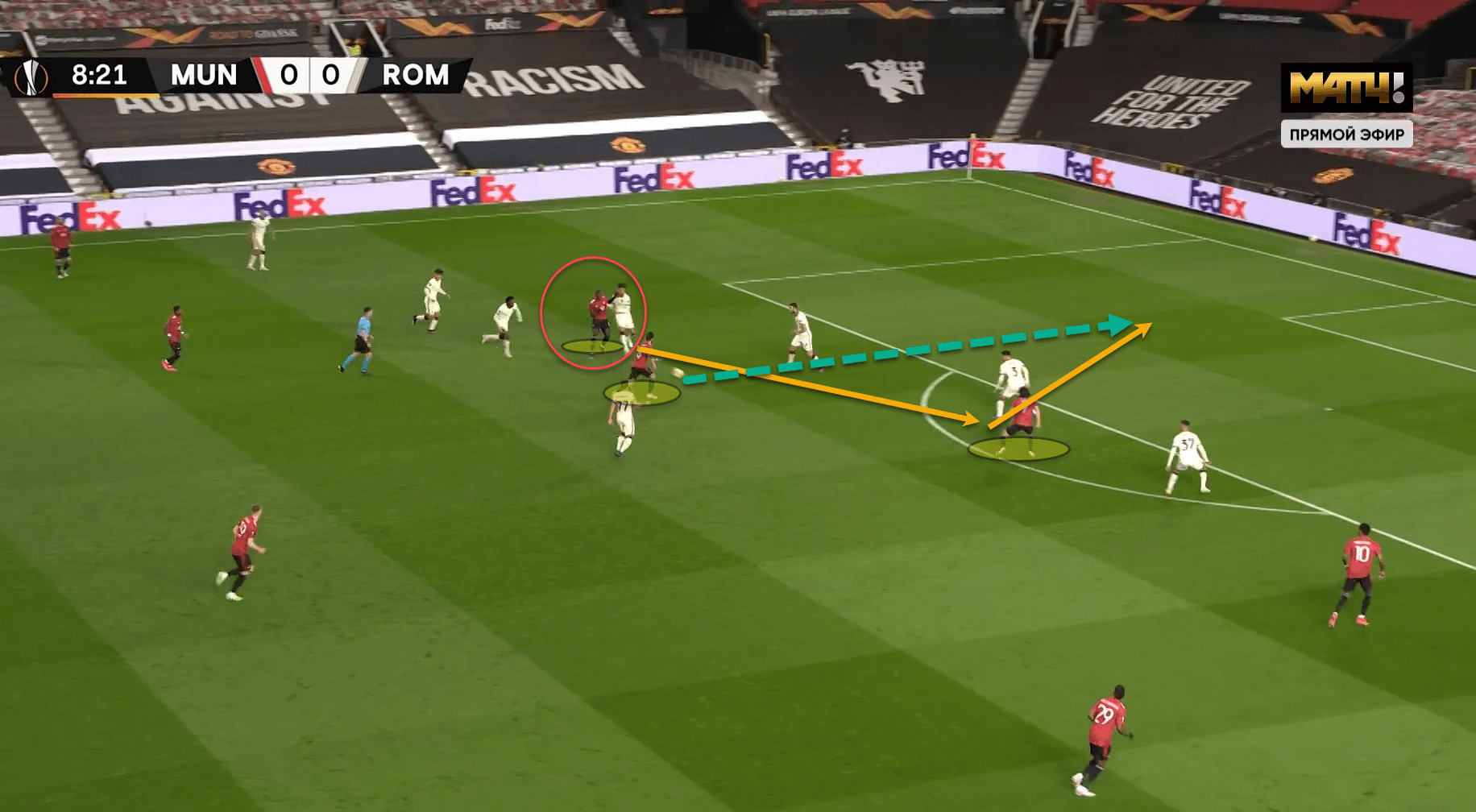
Here is the move that United scored from to open the scoring in Thursday’s goal-fest. Pogba received the ball in the left halfspace and was aggressively closed down by Chris Smalling as well as Villar and Diawara.
However, through his unbelievable dribbling ability and individual talent, he managed to escape from the pressure and find Cavani calling for the ball with his body orienting goalward. It would have been far too difficult for Pogba to try and slip the Uruguayan in on his right foot between Ibanez and Spinazzola and so instead he played to the veteran striker’s left foot.
Before Pogba had even played the ball to Cavani’s feet, Fernandes had already begun his third-man run in behind Cristante and so Cavani knew to instantly try and slip the Portuguese midfielder in on goal before he dinked home the opener.
To famously quote former Barcelona midfielder Xavi, “the third-man run is impossible to defend (against)”, and United certainly showed this. Regardless, as I stated before, we saw very little of this in the first half despite it working so early on in the game.
After the interval, this is something that Solskjaer had tweaked at half-time, and was a minute tactical detail that worked extraordinarily well for the remaining 45 minutes.
Pogba began dropping deeper and deeper to attract the Roma defenders out to aggressively close him down before playing in behind them to exploit the spaces left in behind. He and Shaw would often interchange positions in these deeper areas too with Shaw moving into the left halfspace to drag Karsdorp with him.
Pogba receiving out wide then would pull his marker, Smalling, out of position, leaving massive space for a third-man run in behind the backline.
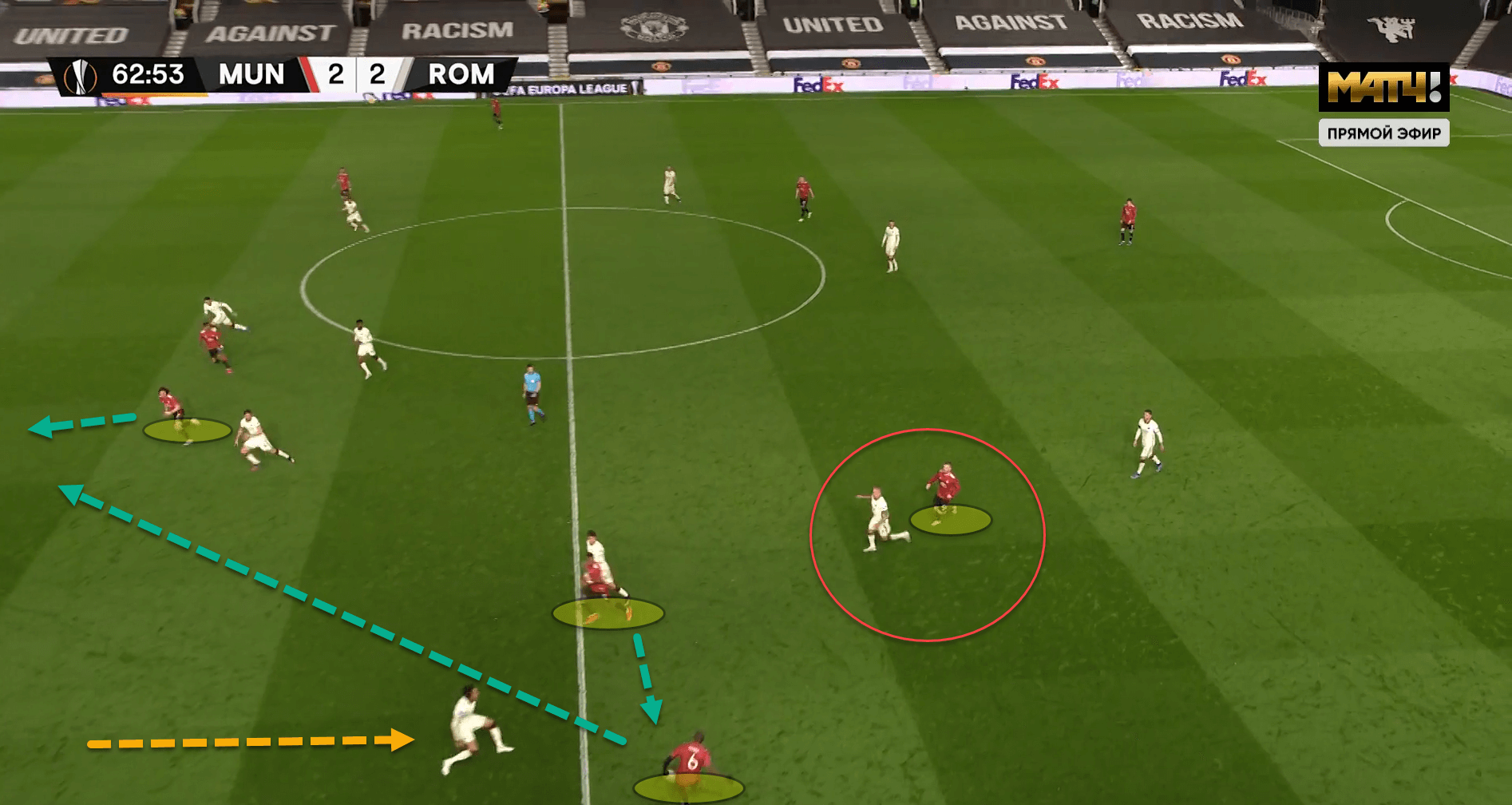
This move set United clean through on goal and within a matter of moments, the ball was in the net for the winner as play developed further.
Solskjaer though did not merely limited United’s attacks on this side to positional interchanges between Pogba and Shaw as that would have gotten predictable and easy to defend against. Instead, other players were tasked with coming across and switching positions with Pogba to create similar patterns of play.
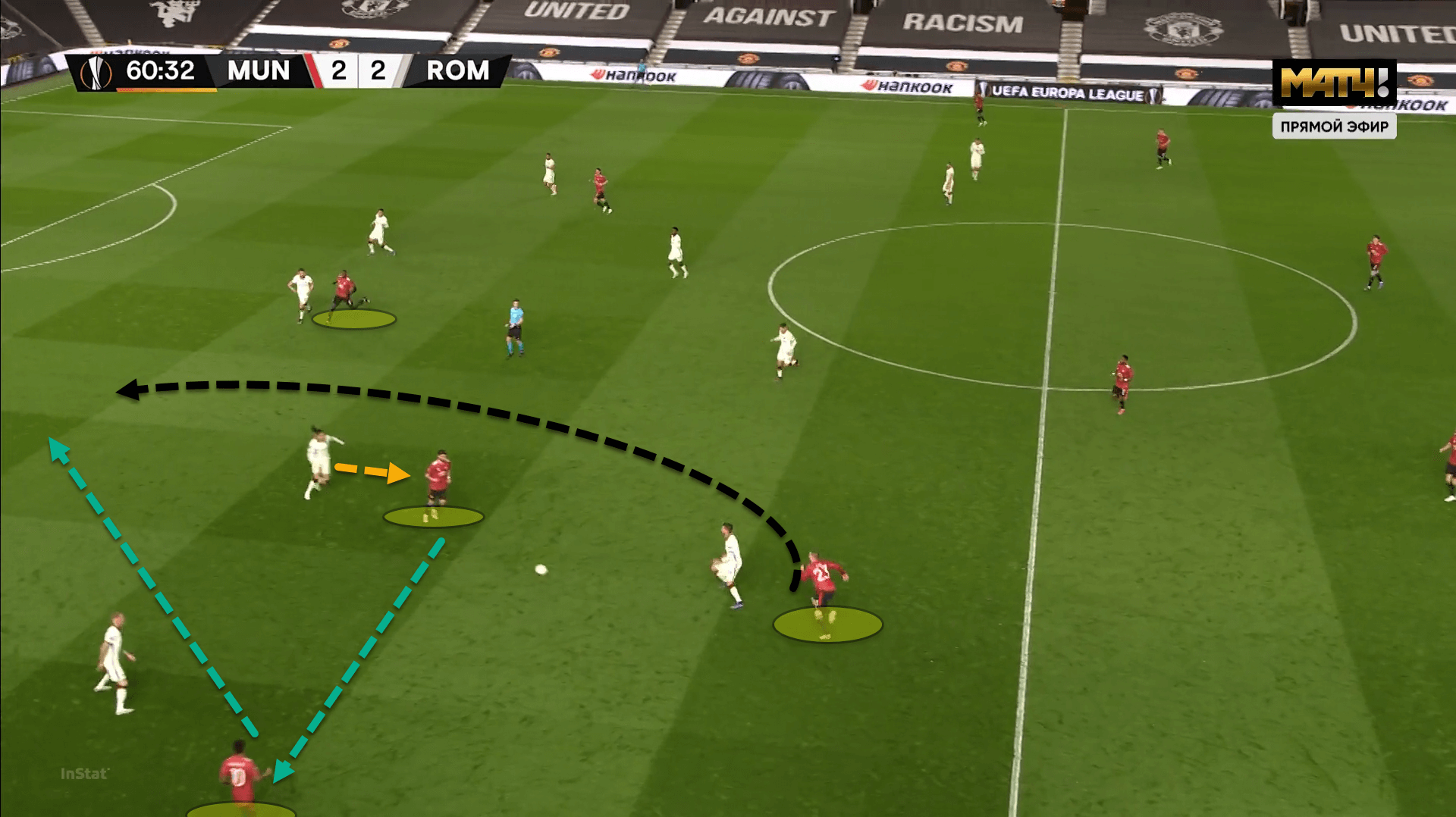
Here again, United use the third-man run of Shaw to get themselves in an excellent goalscoring position. Rashford has come across to the left with Fernandes while Pogba is maintaining a central position, but it is just as effective.
Smalling gets attracted to Fernandes to aggressively press him in the halfspace, leaving space in behind in the mean-time. Pogba’s positioning pinning back Cristante means that the defender cannot come across to close down the space left and so by using Rashford and the third-man run of Shaw into the open space, United get through on goal once more.
Failing to stop the counterattacks
One of Roma’s biggest downfalls in their 6-2 humiliation was their inability to stop their opponent’s rapid counterattacks. Quick transitions from defence to attack are one of the greatest strengths in United’s arsenal and in the second half of Thursday’s match, they were allowed to utilise this to the fullest extent.
In all competitions this season, United average 3.36 counterattacks per 90. Against Roma, they had 6, almost doubling their average tally. Why was this allowed to happen? Surely Fonseca prepared for this when setting his side up for the European semi-final?
The answer was that Roma’s rest defence was really poor at times. Rest defence is essentially how a team sets up structurally in possession so that they can win possession back through counterpressing when they lose the ball.
It is not enough to say that they were beaten in transition several times because they played a high-line in possession as teams like Manchester City and Barcelona all play high-lines but are successful.
When Roma had the ball in their in-possession structure, there were many times when certain Man United players were left in plenty of space so that when their team won the ball, they were open to transition quickly.
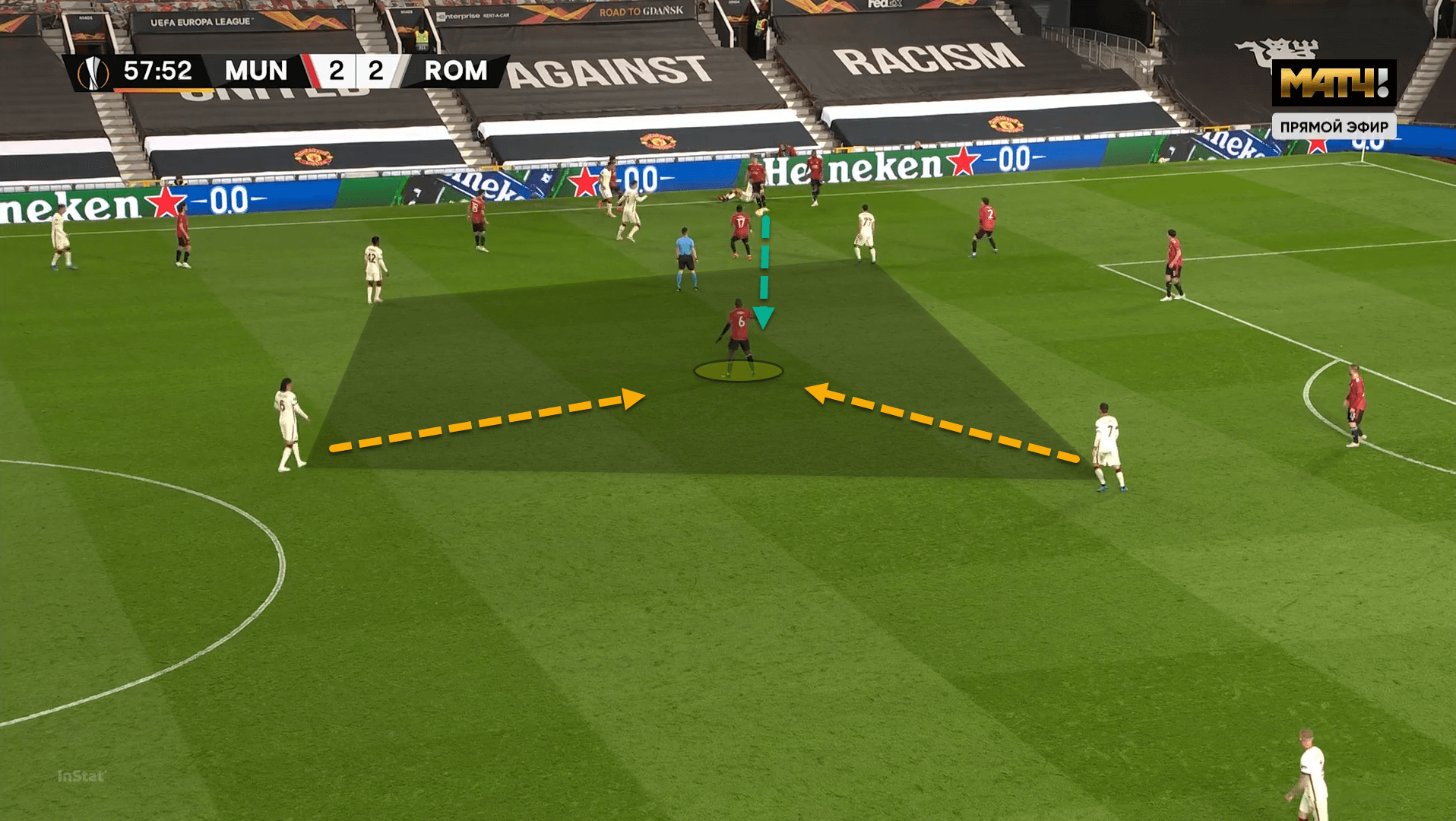
Here is the best example of Roma’s poor rest defence. The Giallorossi had a thrown in over on the left flank. Pogba was left between four of their players in plenty of space and did not possess an immediate threat since Roma were in possession of the ball.
Despite Smalling and Mkhitaryan being free from marking anyone and the two closest players to Pogba, neither took the initiative to close down the Frenchman. When United won possession, the ball was quickly played to his feet as he was open in a good area and by the time Roma’s players could close him down, it was too late and he had already released the ball, setting the forwards away on a counterattack.
Roma did do damage to United
The intention was not to make this article about the structural problems of Roma in a negative way but when a team concedes six goals in a European semi-final, it is difficult to find many things to write home about.
Nonetheless, Roma did cause United significant damage, particularly in the first half when they were the better side defensively and offensively and got themselves 2-1 in the lead heading into the break.
The Giallorossi persistently created combinations and wide overloads down the left flank, their preferred side. By doing so, United were forced to shift their 4-4-2 deep defensive block across to ensure that they are not outnumbered on the left flank. This, of course, left Karsdorp free on the opposite side for a switch of play.
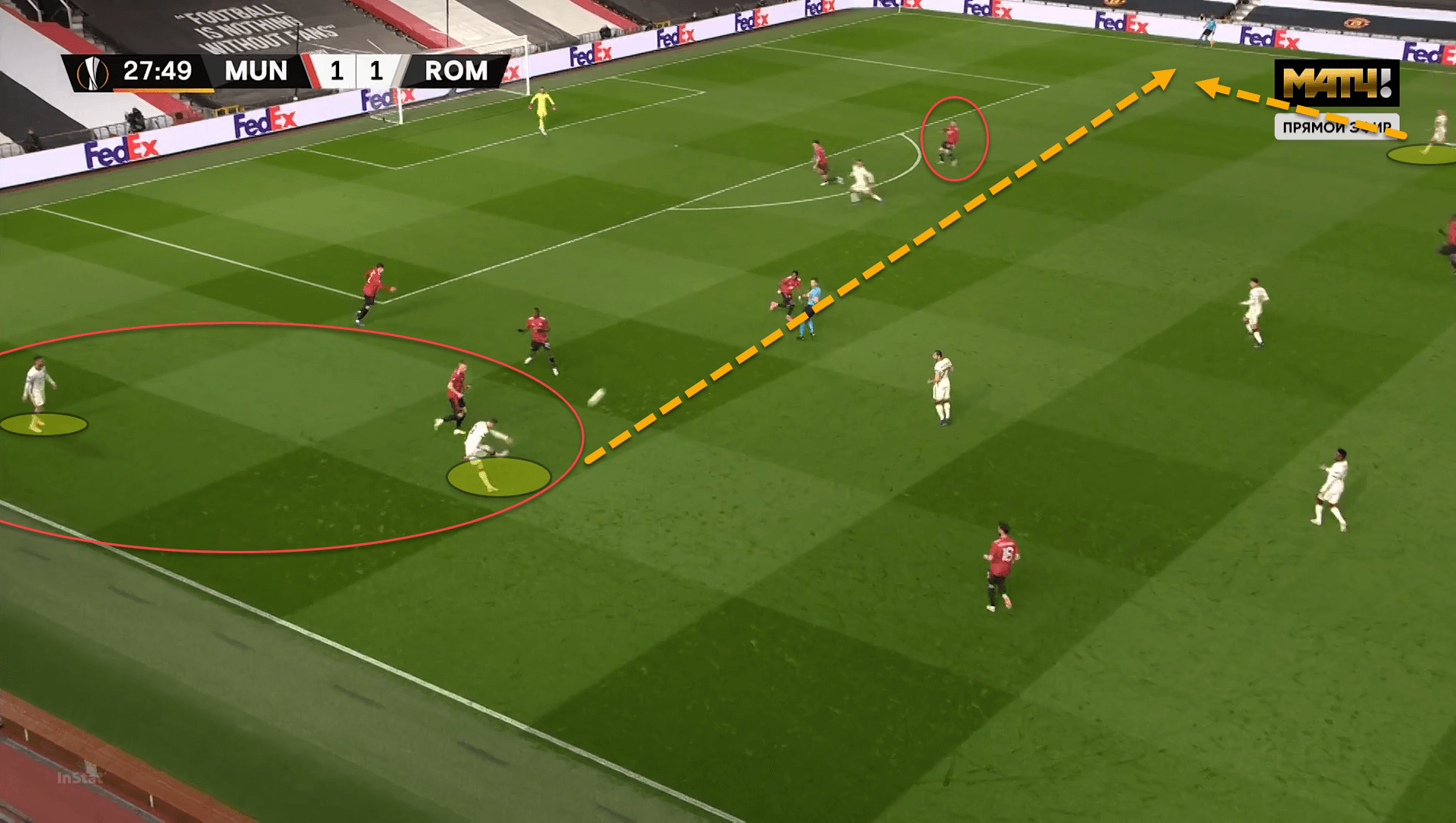
This type of play led to the opening goal when Karsdorp’s cross hit Pogba’s hand and a penalty was awarded by the referee. Combination play on the left flank also led to the second goal too after some horrific defending from Manchester United’s backline.
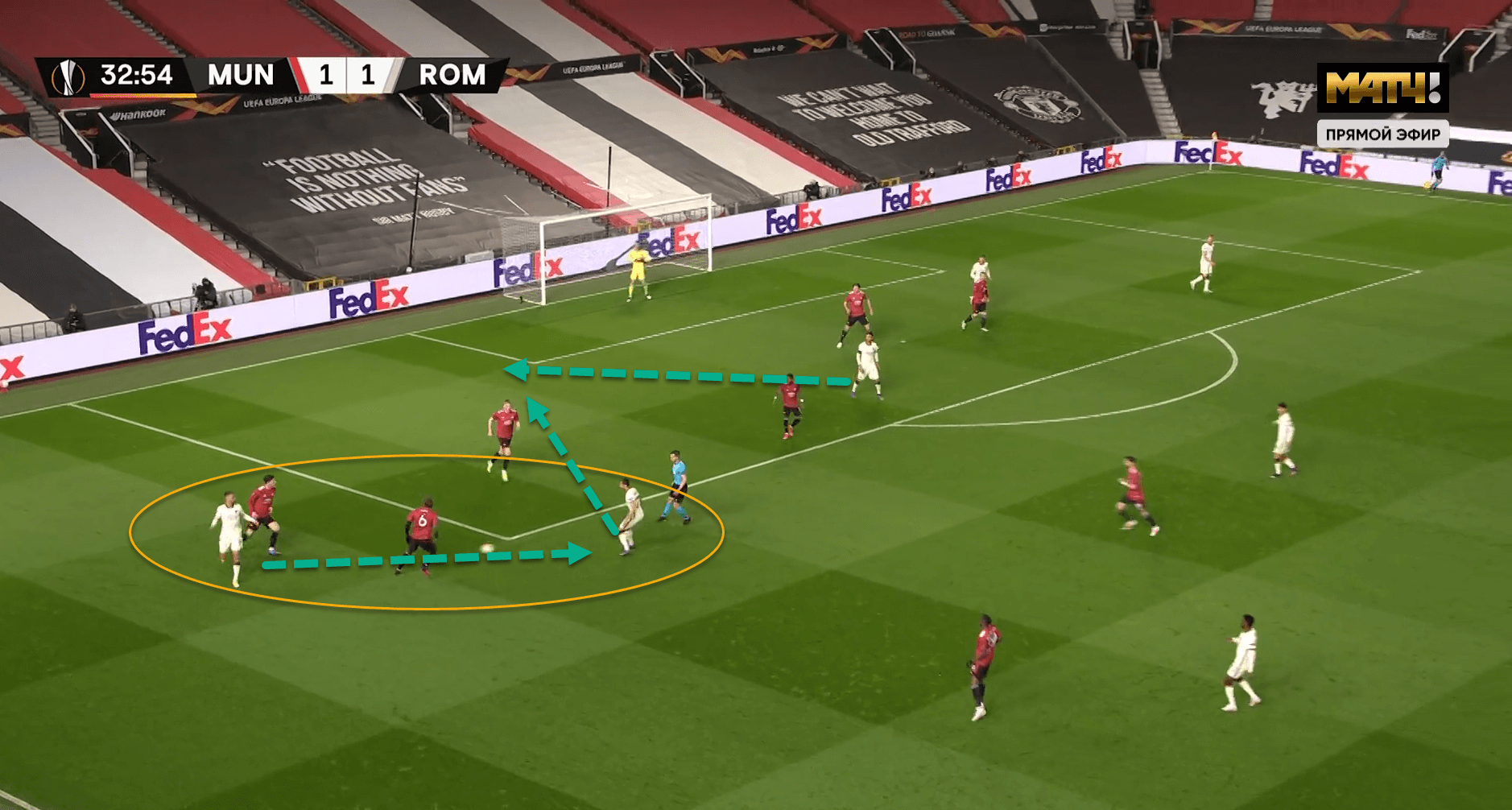
Conclusion
Tactically, the game was good and both managers set their teams up well from the get-go particularly Fonseca. Roma were nullifying United’s attacking threat and hitting them on the break. However, Solskjaer’s subtle tweaks at half-time as well as Fonseca’s failures to adapt his side’s tactics to those changes was what ultimately helped United thrash their opponents in the end to become the first side to score six goals in a European semi-final since Real Madrid in the European Cup in 1964.






Comments